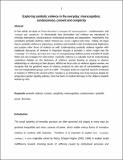Exploring symbolic violence in the everyday : misrecognition, condescension, consent and complicity
Abstract
In this paper, we draw on Pierre Bourdieu's concepts of 'misrecognition', 'condescension' and 'consent and complicity' to demonstrate how domination and violence are reproduced in everyday interactions, social practices, institutional processes and dispositions. Importantly, this constitutes symbolic violence, which removes the victim's agency and voice. Indeed, we argue that as symbolic violence is impervious, insidious and invisible, it also simultaneously legitimises and sustains other forms of violence as well. Understanding symbolic violence together with traditional discourses of violence is important because it provides a richer insight into the 'workings' of violence, and provides new ways of conceptualising violence across a number of social fields and new strategies for intervention. Symbolic violence is a valuable tool for understanding contentious debates on the disclosure of violence, women leaving or staying in abusive relationships or returning to their abusers. While we focus only on violence against women, we recognise that the gendered nature of violence produces its own sets of vulnerabilities against men and marginalised groups, such as LGBT. The paper draws on empirical research conducted in Sweden in 2003. Sweden is an interesting case study because despite its progressive gender equality policies, there has been no marked decrease in violence towards women by men.
Citation
Thapar-Björkert , S , Samelius , L & Sanghera , G S 2016 , ' Exploring symbolic violence in the everyday : misrecognition, condescension, consent and complicity ' , Feminist Review , vol. 112 , no. 1 , pp. 144-162 . https://doi.org/10.1057/fr.2015.53
Publication
Feminist Review
Status
Peer reviewed
ISSN
0141-7789Type
Journal article
Description
The empirical material for the article was collected during a project funded by FAS (now FORTE), the Swedish Research Council for Health, Working Life and Welfare.Collections
Items in the St Andrews Research Repository are protected by copyright, with all rights reserved, unless otherwise indicated.

